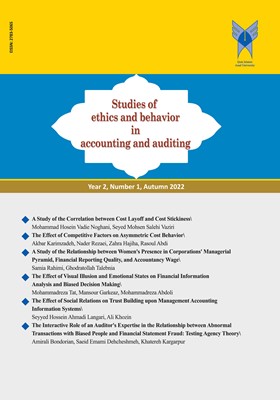A Study of the Correlation betweenCost Layoff and Cost Stickiness
Subject Areas : Ethics and accountingMohammad Hosein Vadeei Noghani 1 , Seyed Mohsen Salehi Vaziri 2
1 - Associate Professor, Department of Accounting, Faculty of Administrative and Economic Sciences, Ferdowsi University, Mashhad, Iran
2 - PhD., Student, Department of Accounting, Faculty of Administrative and Economic Sciences, Ferdowsi University, Mashhad, Iran
Keywords: Cost stickiness, Behavior, labor, Legal Claims,
Abstract :
Purpose: The purpose of the present study is to review the correlation between layoff cost and asymmetric cost behavior or cost stickiness.Methods: The number of workers and legal claim costs for searching layoff costs were chosen as 2 criteria in this research. The sample under study included 108 corporations accepted in Tehran Stock Exchange during 2016-2021.Results: An increase in the number of workers leads to more labor cost stickiness and if their number declines, labor cost stickiness decreases too. As for legal claims, if a corporation has more legal claims, labor cost stickiness goes up and if it has less legal claims, labor cost stickiness comes down too.Conclusions: Layoff costs play a main role in moderating cost behavior models.
بهار مقدم، مهدی؛ خادمی، ساسان (1395). بررسی چسبندگی هزینهها در دورههای رونق و رکود اقتصادی. حسابداری مدیریت، 9(30)، ص67-86.
عنایتپور، ابراهیم؛ مرادی، زهرا؛ اسدیفر، احد؛ درخشان، جواد (1398). تاثیر تمرکز مالکیت بر رابطه بین چسبندگی هزینه و ریسک شرکتهای پذیرفته شده در بورس اوراق بهادار تهران. چشمانداز حسابداری و مدیریت، 2(20)، ص1-15.
محفوظی، غلامرضا؛ ابوالحسنی، محمدتقی؛ شیرپور آبکنار، حدیقه (1397). ارتباط سرمایه سازمانی و رفتار چسبنده هزینههای فروش، عمومی و اداری. دانش مدیریت و حسابداری،7(26)، ص159-174.
نصیرزاده، فرزانه؛ عباسزاده، محمدرضا؛ حسینیپور، رضا (1398). عوامل تعیینکننده رفتار چسبندگی هزینهها. دانش حسابداری، 10(4)، ص177-214.
نمازی، محمد؛ فتحعلی، اکرم (1396). بررسی تأثیر سرمایۀ فکری بر چسبندگی هزینهها در شرکتهای پذیرفته شده در بورس اوراق بهادار تهران. بررسیهای حسابداری و حسابرسی، 24(3)، ص395-420.
نیککار، جواد؛ جلیلی، اکرم (1394). تاثیر تعدیلکننده انتظارات آتی و تغییرات فروش گذشته بر عدم تقارن رفتار هزینه. پژوهشهای کاربردی در گزارشگری مالی، 4(2)، ص99-124.
همهخانی، صادق؛ رویایی، رمضانعلی (1401). تاثیر عوامل فرهنگی بر چسبندگی هزینهها. پژوهشهای حسابداری مالی و حسابرسی، 14(54)، ص159-178.
Anderson, M.C., Banker, R.D. & Janakiraman, S.N. (2003). Are selling, general, and administrative costs “sticky”? J. Account. Res., 41(1), p.47-63.
Banker, R., Byzalov, D. & Chen, L. (2013). Employment protection legislation, adjustment costs and cross-country differences in cost behavior. J. Account. Econ., 55(1), p.111-127.
Banker, R.D., Basu, S., Byzalov, D. & Chen, J.Y. (2016). The confounding effect of cost stickiness on conservatism estimates. Journal of Accounting and Economics, 61(1), p.203-220.
Banker, R.D., Byzalov, D., Ciftci, M. & Mashruwala, R. (2014). The moderating effect of prior sales changes on asymmetric cost behavior. Journal of Management Accounting Research, 26(2), p.221-242.
Chen, C., Lu, H. & Sougiannis, T. (2012). Theagency problem,corporate governance,and the asymmetrical behavior of selling,general,and administrative costs.Contemporary. Accounting Research, 29(1), p.252-282.
Cheung, J., Kim, H., Kim, S. & Huang, R. (2016). Is the Asymmetric Cost Behavior Affected by Competition Factors? Asia-Pacific Journal of Accounting&Economics, No.23, p.1-17
Choi, S., Hwang, I. & Park, J.H. (2019). Managerial ability and asymmetric SG&A cost behavior. papers.ssrn.com
Cooper Jr, W.E. & Blumstein, D.T. (2014). Novel effects of monitoring predators on costs of fleeing and not fleeing explain flushing early in economic escape theory. Behavioral Ecology, 25(1), p.44-52.
Cooper, R. & Kaplan, R.S. (1992). Activity-based systems: Measuring the costs of resource usage. Accounting horizons, 6(3), p.1-13.
Dierynck, B., Landsman, W.R. & Renders, A. (2012). Do managerial incentives drive cost behavior? Evidence about the role of the zero earnings benchmark for labor cost behavior in private Belgian firms. Account. Rev., 87(4), p.1219–1246.
Ghaly, M., Anh Dang, V. & Stathopoulos, K. (2017). Cash holdings and labor heterogeneity: the role of skilled labor. Rev. Financial Stud., 30(10), p.3636–3668.
Golden, J., Mashruwala, R. & Pevzner, M. (2020). Labor adjustment costs and asymmetric cost behavior: An extension. Management Accounting Research, No. 46, p.100647.
Haas, D.H. & Kajan, D. (2017). Cost stickiness during the financial crisis. Rational resource management or wasteful overspending? 5(5), p.44-54.
Hartlieb, S., Thomas, R.L. & Eierle, B. (2020). Does community social capital affect asymmetric cost behaviors? Management Accounting Research, 46, p.100640.
Homburg, C., Hoppe, A., Nasev, J., Reimer, K. & Uhrig-Homburg, M. (2018). How CostStickiness Affects Credit Risk. URL= https://ssrn.com/abstract=2792085
Hwang, H., Ko, H. & Son, H. (2021). Does the Ownership of Domestic and Foreign State Affect Asymmetric Cost Behavior? DOI: 10.24056/KAR.2021.08.005
Isidro, H., Nanda, D. & Wysocki, P. (2016). Financial reporting differences around the world: what matters? URL= https://ssrn.com/abstract=2788741
Jeong-Ho, K., Seungah, S. & Tae Young, P. (2015). Earning management and costs tickiness. Advanced Scienceand Technology Letters, No. 84, p.40-44.
Manning, A. (2006). A generalized model of monopsony. Econ. J., No. 116, p.84–100.
Nicola, D. & Pado, P. (2013). Evidence from small and medium sized companies Sticky cost behavior. Accounting & Finance Journal, 4(5), p.2-89.
Oi, W. (1962). Labor as a quasi-fixed factor. J. Political Econ., No. 70, p.538-555.
Shen, J. & Zhang, R. (2018). Cost Stickiness, Ownership Concentration and Fixed Assets Investment. In: 8th International Conference on Management and Computer Science (ICMCS 2018).
Supriyanto, S. (2021). Analisis Pengaruh Karakteristik Dewan Terhadap Asymmetric Cost Behavior pada Perusahaan yang Terdaftar di Bursa Efek Indonesia Tahun 2014-2018. Journal of Applied Accounting and Taxation, 6(2), p.205-217.
Warganegara, D.L. & Tamara, D. (2014). The impacts of cost stickiness on the profitability of Indonesian firms. International Journalof Social, Behavioral, Educational, Economic. Business and Industrial Engineering, 8(11), p.3602-3605.
Xue, S. & Hong, Y. (2016). Earnings management, corporate governance and expense stickiness. China Journal of Accounting Research, 9(1), p.41-58.
Yao, K. (2018). Cost Stickiness, Ownership Concentration and Enterprise Risk Empirical Evidence from Chinese Listed Manufacturing Companies. American Journal of Industrial and Business Management, No. 8, p.163-173.
_||_

